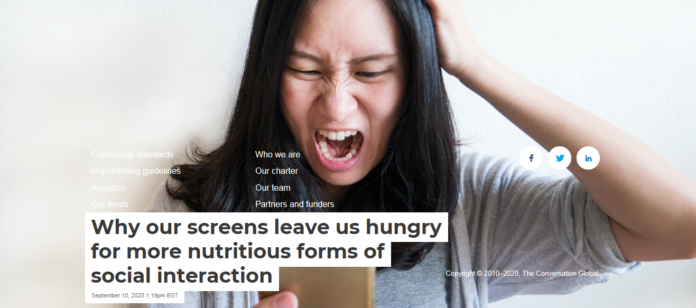
mc schraefel, University of Southampton
COVID-19 has seen all the rules change when it comes to social engagement. Workplaces and schools have closed, gatherings have been banned, and the use of social media and other online tools has risen to bridge the gap.
But as we continue to adapt to the various restrictions, we should remember that social media is the refined sugar of social interaction. In the same way that producing a bowl of white granules means removing minerals and vitamins from the sugarcane plant, social media strips out many valuable and sometimes necessarily challenging parts of “whole” human communication.
Fundamentally, social media dispenses with the nuance of dealing with a person in the flesh and all the signalling complexities of body language, vocal tone and speed of utterance. The immediacy and anonymity of social media also remove the (healthy) challenges of paying attention, properly processing information and responding with civility.
As a result, social media is a fast and easy way to communicate. But while the removal of complexity is certainly convenient, a diet high in connections through social media has been widely shown to have a detrimental effect on our physical and emotional wellbeing.
Increased anxiety and depression are well-known side-effects. There are also consequences for making decisions based on simplistic, “refined” sources of information. We may be less discerning when it comes to evaluating such information, responding with far less reflection. We see a tweet, and we are triggered by it immediately – not unlike a sugar hit from a bar of chocolate.
More complex kinds of communication demand more of us, as we learn to recognise and engage with the complexities of face-to-face interaction – the tempo, closeness and body language that make up the non-verbal cues of communication that are missing in social media.
These cues may even exist because we have evolved to be with others, to work with others. Consider, for example, the hormone oxytoxin, which is associated with trust and lower stress levels and triggered when we are in the physical company of others.
Another indicator of trust and engagement is the fact that group heart rates synchronise when working together. But achieving such rhythm of communication takes effort, skill and practice.
Pause for thought
There’s an interesting element of elite athletic performance known as “quiet eye”. It refers to the brief moment of pause before a tennis player serves or a footballer takes a penalty to focus on the goal. Good communicators, too, seem to take this pause, whether it’s in a presentation or a conversation – a moment lost in social media’s rush for an immediate anonymous response.
Having said all this, I don’t believe social media – or table sugar for that matter – is fundamentally wrong. As with a slice of cake on a special occasion, it can be a delight, a treat and a rush. But problems appear when it is our dominant form of communication. As with only eating cake, it weakens us, leaving us far less able to thrive in more challenging environments.
COVID-19 has meant a greater proportion of many people’s lives are spent online. But even Zoom meetings and gatherings, while more intimate than a tweet or social media post, also have limitations and lead to fatigue.
In physiological terms, part of the reason for these experiences being so challenging is that we are supposed to connect with each other in person. We are wired to deal with every aspect of physically present personal contact – from the uncomfortable conversations to the hugely gratifying exchanges.
We suffer without it. We see this in energy levels, overall health and mental stability. It’s physical as well as emotional in effect. Indeed, researchers have shown for over a decade now that loneliness kills. What research has yet to show is if social media mitigates this.
Read more:
Coronavirus: experts in evolution explain why social distancing feels so unnatural
Again, virtual meetings are not intrinsically wrong. But they are not sufficient, in human physiological terms, to sustain what we have come to need after 300,000 years of evolution.
Even in the days before coronavirus, social media had been evolving into a dominant means of communication for many. Fast and easy, but also often mean, judgemental, fleeting – something that does not bring out the best in us.
The hope in offering this analogy is that by contextualising how social media works in terms of our physiology, we can start to understand how we may need to balance social media with other more challenging, but ultimately more satisfying forms of communication. And also how we may need to design virtual methods of communication that embrace more of the physiology of social contact that we need, and which helps us to thrive.![]()
mc schraefel, Professor of Computer Science and Human Performance, University of Southampton
This article is republished from The Conversation under a Creative Commons license. Read the original article.




















